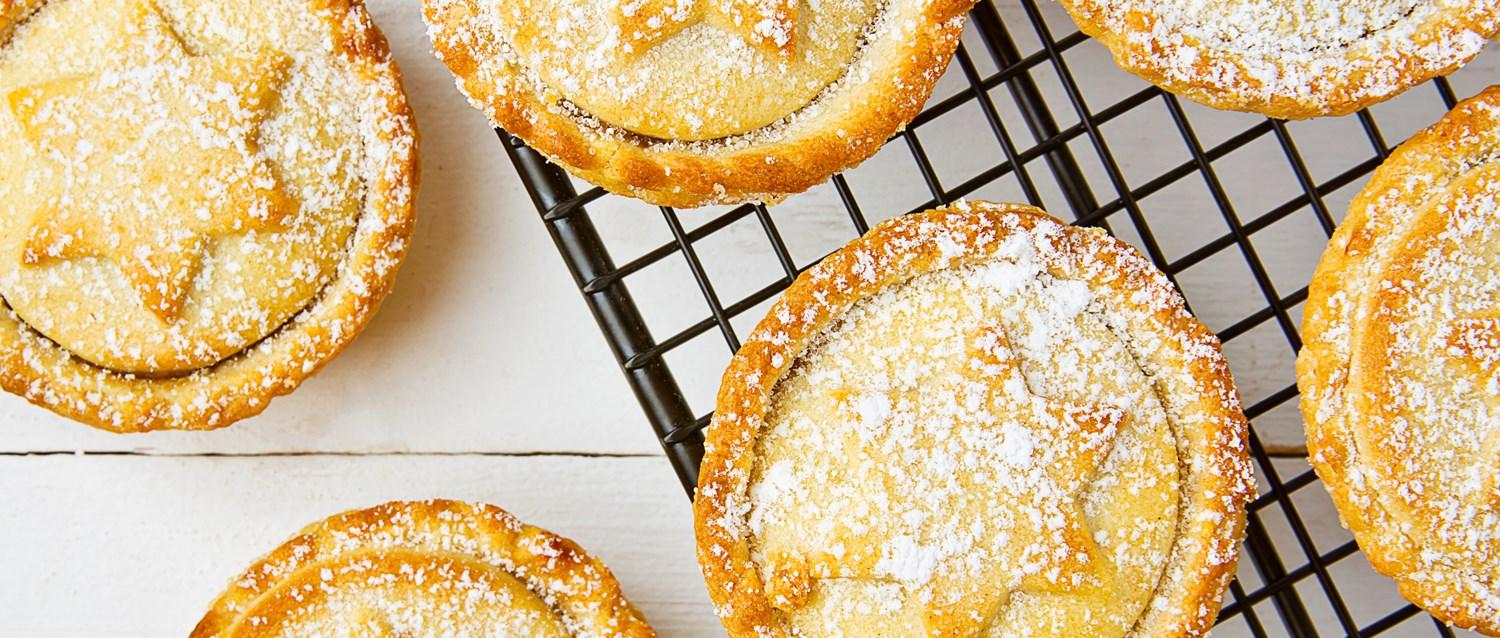
How to make healthy mince pies
Peer reviewed by Dr Sarah Jarvis MBE, FRCGPLast updated by Natalie HealeyLast updated 13 Dec 2017
Meets Patient’s editorial guidelines
- DownloadDownload
- Share
- Language
- Discussion
When did you have your first mince pie this year? The appearance of these festive treats in the shops marks the start of Christmas for many. However, due to their high sugar and fat content, they're hardly a healthy snack. We say everything in moderation but is there a way of making a nutritious mince pie?
We put three professional chefs (Bradley, Reece and Renaldo) from the Good Eating Company to the challenge. We then got nutritionist Rose Constantine Smith to analyse their efforts.
In this article:
Rose says: "The content of a mince pie isn't entirely bad. The main ingredient is fruit, meaning it is high in fibre and nutritional value, but it's important to remember that dried fruit is also naturally high in sugar. The main elements of a mince pie which add to the calories and fat are the suet in the filling and the pastry."
Continue reading below
Bradley's Gluten-Free Mince Pies
Bradley Sinkins is head chef at Engine. He says: "I chose to use Flora Light to improve the fat content. I also used gluten-free flour so that it will be suitable for those with a gluten intolerance."
Ingredients (Makes 10 mince pies)
For the pastry:
200g gluten-free flour (plus extra for dusting)
100g Flora Light plus extra for oiling
75ml cold water
2 tbsp icing sugar, for dusting
For the filling:
200g dried mixed fruit
Zest of 1 orange grated
Juice and zest of 1 lemon grated
4 tbsp sugar-free apple purée
½ nutmeg
Grated ½ tsp ground ginger
½ tsp vanilla essence
1 tsp ground cinnamon
2 tbsp Flora Light
Method
Using your hands, mix the flour, flora and water together in a large mixing bowl until it all comes together to form a dough.
Wrap in clingfilm and chill in the fridge for 30 minutes.
Meanwhile, to make the filling, put all the ingredients in a blender and roughly mix. Set aside.
Preheat oven to 180°C/350°F/Gas Mark 4 and lightly oil 10 holes of the cupcake/muffin tray with Flora.
Lightly dust a clean surface with flour and roll out your chilled dough to about 5mm thick, then cut into 20 rounds with the cutter.
Put half your circles into the prepared tray holes. Push them gently down around the edges.
Once complete put one teaspoon of filling into the middle of each round, then place the leftover circles of pastry on top and push the edges gently to seal.
Using a fork, crimp the edges and pierce the top of each pie. Bake in the oven for about 20 minutes, or until slightly golden.
Remove from the oven and leave to cool.
Sprinkle with a little icing sugar and serve.
Reece's Spelt Flour Mince Pies
Reece Taylor is head chef at Arup. He says: “I'm making my mince pies more nutritious by using spelt flour which gives them a higher fibre content than when white flour is used. I haven't added sugar to the pastry.”
Ingredients
Makes 22
For the pastry:
500kg organic spelt flour
125g organic unsalted butter
125g organic lard
2 egg yolks
125ml ice cold water
For the filling:
1.5kg dried raisins
1.5kg dried sultanas
750g dried currants
750kg dried mix peel
1.5kg grated cox apple
1.35kg dark brown sugar
500g flaked almond
7.5g lemon zest
7.5g orange zest
7.5g orange juice
1.5kg vegetarian suet
115g mixed spice
30g cinnamon
15g nutmeg
400ml brandy
100ml Grand Marnier
500kg organic unsalted butter
Method
Preheat the oven to 100°C.
Mix all mincemeat ingredients except the alcohol in an ovenproof dish, place a lid on top and bake for 3 hours.
Once cool add the alcohol and turn periodically. This can be done as far in advance as possible, even the year before if sealed in sterilised jars.
For the pastry, preheat the oven to 200°C.
Then in a large bowl crumble together the butter and flour until it resembles breadcrumbs.
Add the egg yolks and water and mix gently with a spoon, working fast to keep it cold.
Once it forms a dough, place onto a clean, floured surface and roll out to roughly 2cm thick. Using a circular cutter which fits your muffin, cut the pastry into circles and place in the tray holes.
Evenly distribute the mincemeat mixture into each of the holes and top with another disk. Crimp the edge to seal and bake immediately, while the pastry is still cold for 18 minutes or until golden.
Continue reading below
Renaldo's Maple Syrup Mince Pies
Renaldo is head chef at Henry Wood House. He says: "I have substituted the sugar in the pastry for maple syrup and a small amount of pomegranate molasses as they do have some nutritional value, unlike white sugar. Also, instead of white flour, I am using wholemeal as it is higher in nutritional value."
Ingredients
For the pastry (Makes 16):
375g wholemeal flour
100g olive oil
100g unsalted butter
80g maple syrup
20g pomegranate molasses
2 eggs (one for egg wash at the end)
For the filling (Makes 24):
200g maple syrup
175g sultanas
175g raisins
175g currants
1 large cooking apple
100ml brandy
100ml baileys
100g vegetable suet
Rind and juice of ½ orange
Method
First make your mincemeat. Place your maple syrup, Baileys and brandy into a saucepan and put on a low heat.
Dice your apple into small cubes about half a centimetre then add this to your pan. Stir frequently to stop them catching.
When your apple has softened add your spices and then your raisins, sultanas and currants stir to combine.
Now add your orange juice and zest and stir a final time to mix.
You want to reduce this down until the syrup glazes your fruit. You don't want pools of liquid!
Once you have your consistency add your vegetable suet and let cool. Now you're ready to fill your pastry.
Put the wholemeal flour in a bowl with your cold butter. Work this together with your fingers until you have a fine crumb. You can also do this in a mixer.
Now beat one egg and add to the mix with your other ingredients. Work together until you have a pastry that you can roll out. Your pastry shouldn't be dry if so add a touch of water to the mix. Also if your pastry is too wet add a little flour.
Roll out your pastry onto a clean floured surface and cut into rounds using cutters. Your lids should be 2cm smaller than your bases (depending on the side of your tins) and your pastry should be around 3 mm thick.
Now spray your tins with non-stick spray or coat with a little butter and put your large rounds into your moulds.
Fill the base about half a centimetre from the top of the pastry. Beat the remaining egg and brush the edges of the pastry and put the lids on and close with your fingers, crimping the edges. You should be able to make a seal all around.
Egg wash the tops of the pies and poke a hole in the top with a knife just enough to let the steam out.
Cook at 220°C /220°C fan oven for 15 mins or until the tops are firm and golden brown.
The nutritionist's view
Rose says:
Bradley
"Bradley did brilliantly at reducing the fat content. He dropped it by roughly 17.4g when compared with a standard homemade mince pie. He did this by substituting all the fats with Flora Light. As he used white, gluten-free flour it is suitable for all but is lower in fibre than the others."
Renaldo
"Renaldo focused on increasing the nutritional value of his mince pies by using wholemeal flour for the pastry, swapping the fat for olive oil and to sweeten, maple syrup and pomegranate molasses which although still provided the same amount of sugar as a classic mince pie, provide more nutritional bang for their buck. On the whole, when looking purely at fat, calories and sugar, Renaldo's recipe is only slightly lower when compared with a traditional recipe, it is when looking in closer detail that the changes pay off."
Reece
"Like Renaldo, Reece also looked at boosting nutritional value by using spelt flour which improved the fibre content. In the filling he also added fresh apple which bulked out the filling with a lower sugar form of fruit. When comparing with the traditional mince pie however they are actually slightly higher in fat due to his use of lard and butter in the pastry."
Smart swaps
"As the main contributor of calories is the pastry I would look to swap the traditional short crust for filo and make mincemeat parcels. Filo contains around 30g less fat per 100g than shortcrust so it is a great way to make them a little lighter.
"For the filling I would follow Reece’s idea and add in some fresh fruit like pear or apple and dice it to bulk out the filling and add a fresh sweetness. I'd cook them over a low heat to let their juices seep out and create its own sweet sauce which would mean you could reduce the sugar content.
"None of the chefs thought to use a lattice top to the pies, which would have reduced the proportion of pastry.
"Finally I would look to use a reduced-fat suet or just reduce its quantity."
Patient picks for Recipes

Diet and nutrition
Brain food: what to eat, when to eat, recipes
A healthy diet is very important for your brain function and mental health. We find out the best foods for brain health, the best times to eat, and share some nutritious brain food recipes.
by Andrea Downey

Diet and nutrition
7 vibrant autumn recipes - keep it seasonal
From the warm oranges of squash, pumpkins and carrots to the vibrant purples of blueberries and beetroot, autumn fruits and veggies are as rich in colour as they are in flavour. Not only can they brighten darker evenings, they can lighten up your taste buds with a powerful nutritional punch.
by Victoria Raw
Continue reading below
Article history
The information on this page is peer reviewed by qualified clinicians.
13 Dec 2017 | Latest version

Ask, share, connect.
Browse discussions, ask questions, and share experiences across hundreds of health topics.

Feeling unwell?
Assess your symptoms online for free
Sign up to the Patient newsletter
Your weekly dose of clear, trustworthy health advice - written to help you feel informed, confident and in control.
By subscribing you accept our Privacy Policy. You can unsubscribe at any time. We never sell your data.